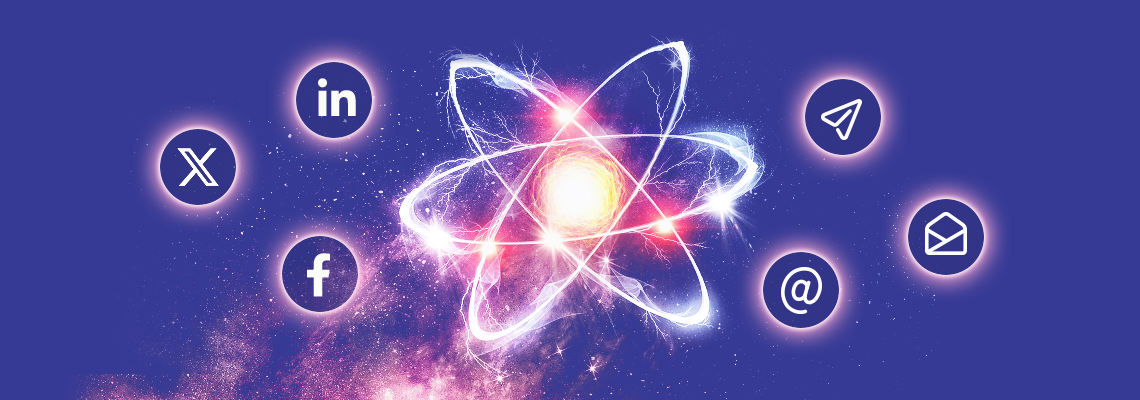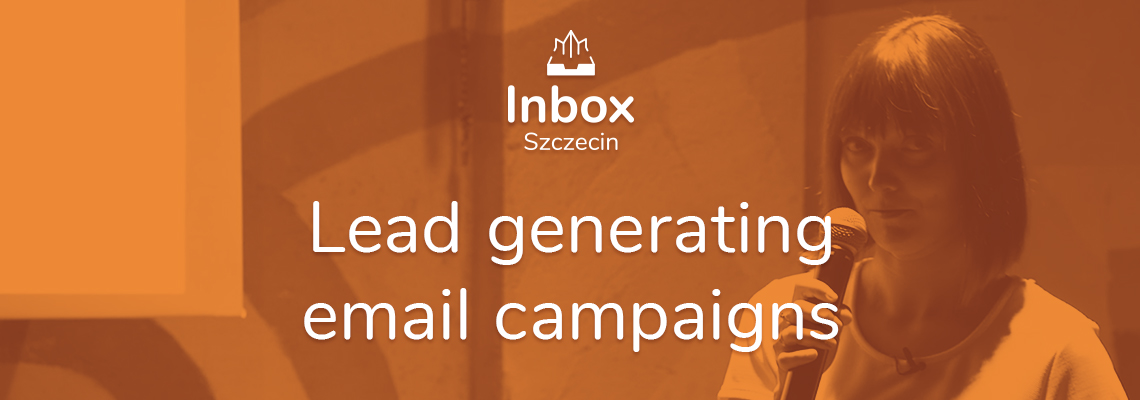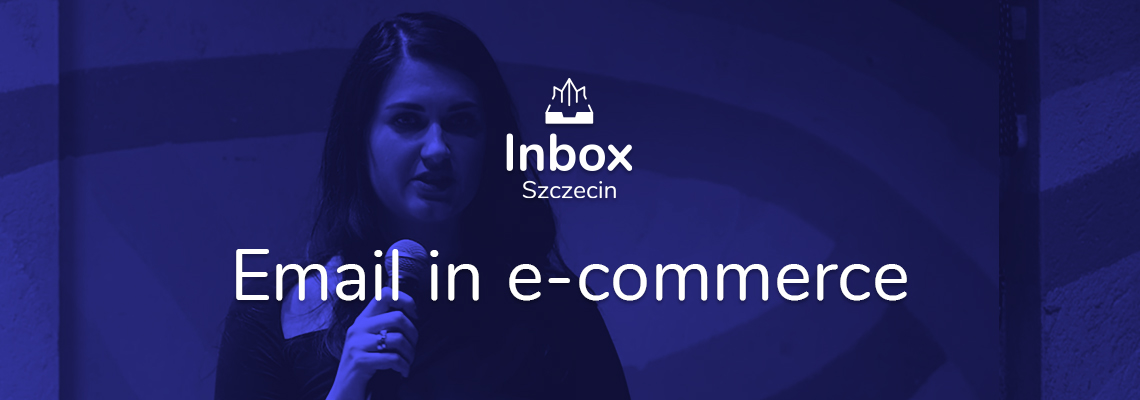Inbox Szczecin is a meeting focused on email marketing and communication via email. Three specialists shared their knowledge and answered the questions of the listeners.
Emails are not exactly as they seem at first. They are quite similar to social media channels. However, in order to show you the differences and similarities between emails and social media, we should first explore a bit of their history. Our third and last presenter - Marcin Puś discussed this topic during the first-ever Inbox Szczecin meeting in October 2019.
Table of Contents
- About Marcin Puś
- The history of social media
- The takeaway
- The characteristic of an email
- How to work with email?
- What do other people think about email?
- Questions
About Marcin Puś
Marcin worked at Elastic Email as Head of Marketing. Online marketing is a core part of his everyday work. Especially around the IT industry, which he is involved in for over 13 years. He is curious about everything related to marketing, communication, and the Internet of Things. Marcin is a blogger, a video editor and a sort of performer. He enjoys a good (and bad) jokes and he launched the Inbox Szczecin project that results you can see in the previous articles and presentations.
The history of social media
It all started in 2002, when the first real social network was created - Friendster. At its peak, it had around 115 million active users and it was one of the first social media channels. Eventually, Friendster crashed and was officially closed in 2014. Between 2003 and 2004 most important channels are LinkedIn, and Facebook with 2,2 billion active users per month. It’s worth keeping this number in mind - 2,2 billion.
Then Grono.net was created, which was very popular in Poland. Personally, I had a rapper friend. He had a huge following on Grono.net, where he posted links to various songs and other content, and then Grono.net suddenly shut down. Long story short, he lost all his followers and is no longer a rapper. In fact, he studied Economics with me.
Bebo was next, I’m sure nobody knows that. Nasza Klasa (polish site) still exists. In 2014 it had around 7 million users, it could be less now. It's really hard to get some specific data in regard to this portal. You would think that Twitter has more users, but they actually have around 336 billion users per month.
Blip - an eastern-european Twitter that disappeared in 2013 with two-months notice. Next is Google+ that also doesn’t exist, Snapchat exists, Vine is pretty much gone, in his place came Tik Tok, I’m going to talk about it in a moment. Here we have Ello, I assume not many of you know what it is. It has around 1 million registered users and there is not much going on there, even on Ello’s main page.
There is Vero that was created recently, but again it got pretty quiet in there. There is also a network channel called Beme that lasted about 2 years. It didn't help much that one of the most known YouTube vloggers in the world created it- Casey Neistat, the service still failed. They burned through around 250 thousand dollars per month just to maintain servers and payments for developers. Nothing helped. And finally, Tik Tok launched in 2017 with 1 million users, now I think there’s much more.
The takeaway
From all the channels I presented here, 16 of them are working and 9 don't exist anymore. So if somebody wants to become an influencer and build their career basis the number of followers, they ideally should be everywhere. They should be on all services or perform exceptionally well on one of them.
However, there are risks. For example, we can put all our energy and money in a social network, that for some reason, either from CEO’s poor decisions will cease to exist, or the terms of use will be changed, and people will move onto another service, that will be more current. In conclusion, social networks come with some uncertainty. And then suddenly an email appears with nearly 50 years of experience, ready to take over the load.
Yeah, email exists for a very long time now, and it’s not going anywhere except forward. The number of email users grows steadily. Currently, we have over 8 billion in the world, with 4.9 billion having access to the Internet. This number is constantly growing. Out of those almost 5 billion people, 4.2 billion has email accounts. That’s about 85% of all Internet users and just to compare, Facebook has almost 3 billion.
I put a screenshot from a very cool page that shows the number of actions taken on multiple social media channels or multiple services overall. Among many, the number of views on YouTube, the number of searches on Google or the number of Facebook posts. At the very top, there’s email, that has 92 and 9 numbers after. It’s so many numbers after this 9, that I had to check for myself what the number with 9 zeros is called. So I looked on Wikipedia, and this number is called a bazillion.
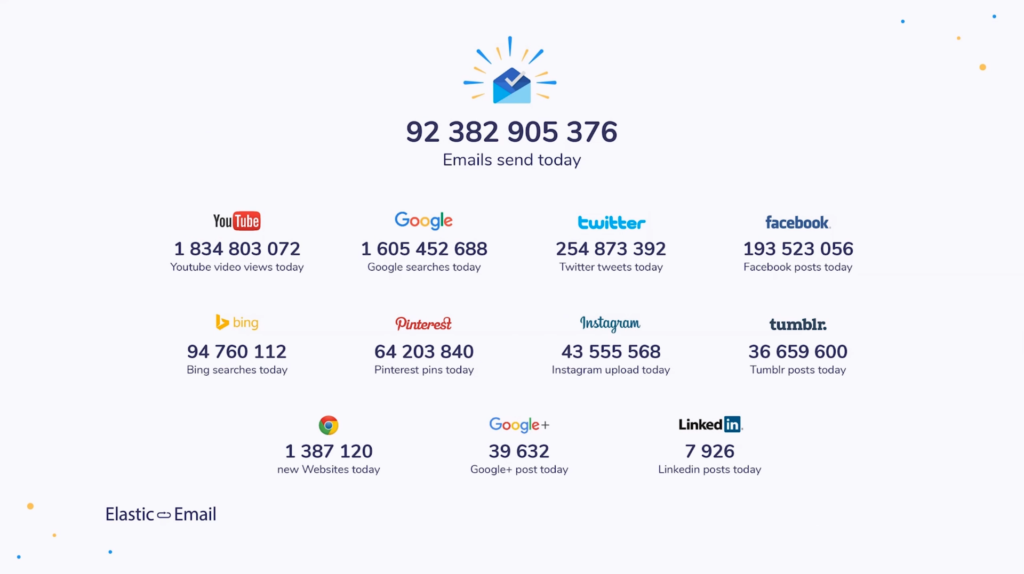
So to sum up, there are 92 bazillions emails sent every day, and that’s a big number, no joke.
Here, we have an indicator showing the number of sent emails. We are starting in 2017 and moving forward to 2022, and you can see that the numbers are steadily growing. Of course, it depends on various factors, but we can safely say that email as a platform is growing consistently for a long time now.
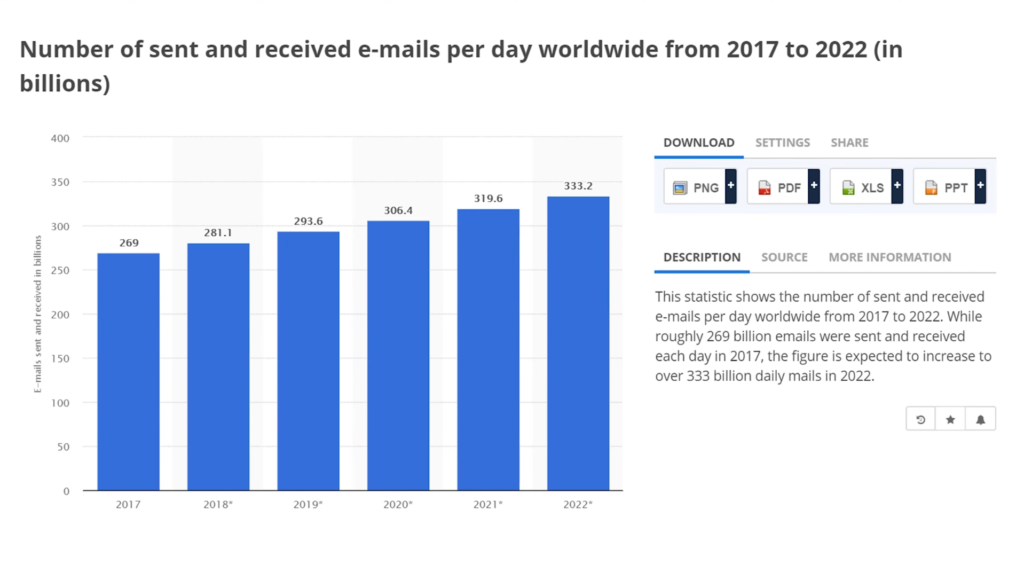
The characteristic of an email
Email is intimate. It’s a type of communication channel, featuring 1 on 1 interaction with a message. When an email arrives, we click on it, open it, read it, and it’s very intimate. Nobody else has access to those emails unless our password is bad. While we’re reading one email, other messages don’t try to steal our attention but wait for their turn to be opened. It’s a very private experience.
Email is personal. There are a lot of elements within emails that we can personalize, as speakers before me mentioned. Not only name but also age, gender and so on. In an email we can write “Hi Michael, today is your birthday. We have for you this anti-aging cream”. We only need to have all this information and we can automate and personalize email well, but it may feel a bit sneaky. On the other hand, it can have a positive impact on the recipient if the birthday wishes from the newsletter are the first ones that this person gets, you know, everybody else forgot - they just might feel a bit better.
Email is bilateral - it goes both ways. One of the characteristics of social media is that they are going both ways. Anybody can write something on Twitter or Facebook, anybody can reply. We can comment under Donald Trump's tweet, he can comment under ours. Emails work in a similar way. If we receive an email message from someone, you can even scroll a bit down in Gmail, and there you have a reply window. This communication can be fast, direct - bilateral.
Email is private. Nowadays we are quite conscious email users, especially if we have more than one account. Usually, we have one main account, about safety we care the most, due to the nature of the emails we receive - invoices, bills, etc. We care for its privacy, which is good, since we don’t usually care that much in regard to Instagram privacy, for example. Especially if we don’t really care that much. With email, we realize the responsibility, so we create hard passwords. Maybe some of you - I hope a lot of you - have two-step verification to your main email account.
Email is editable. There is a big difference, between social media and email, in favor of the latter. With Facebook, if we want to publish something, we can post a picture, a video, write a few words or tag someone. Email can be whatever you imagine it to look like. You can change the background, add five, even twenty pictures, we can add GIFs, create a table. There are new technologies developed, where email messages can look like interactive web pages. You can buy or browse directly from the email. There are countless possibilities of editing and creating emails to make it as we want it to look like. It’s hard to find another social network that would give as many options.
And lastly, one of the biggest advantages especially from a marketing point of view. Constant range. If we have 1000 subscribers and we send a newsletter, it will be sent to 1000 subscribers. If you have 1000 fans on Facebook and publish a post, it will sometimes reach 300 people, other times to 700, maybe once it will go viral and reach 1500. In the case of the email, you have the most control over the range. You are beyond the Edgerank algorithm. Did you know, on Facebook, there is an algorithm that decides on the popularity of our posts - how many people will see it on their wall. With email, we control it, through the quality of the messages and more. But if we have a number, the email will be sent to this exact number.
Delivery time control. That’s a neat aspect that most people don’t pay attention to. The delivery time control in social media can be challenging. Let’s say we want to make a huge Friday sale or invite people to the party on Friday at 11 p.m. We post it on the same Friday at around 3 p.m. Post also shows up on Saturday and Sunday. People are starting to get confused. Is the party today, was it yesterday? Sometimes it happens that after a few years someone will comment on an old post and it will float to the top of the page, and people ask - is it up-to-date? They simply don’t see the dates.
In case of an email, once we send it the majority of recipients will open it within the next two hours. When it comes to email the delivery time control is big, and it’s much easier to ensure that the message will reach the inbox when we want it to.
How to work with email?
Okay, so let’s talk on how to work with emails well. First - you need to start. I’m not going to give you such an extensive rundown, as my colleagues, mine is more catered towards amateurs. So when you’re an amateur, you need to start and collect contacts, as we said many times before. You need to gather emails from the very beginning, and the sooner you do it, the better.
Truthfully, you can’t go wrong with collecting subscriptions even if you’re not 100% sure what you’ll send them. The worst-case scenario is, that when you start sending emails, some people will resign from it and unsubscribe, and some will stay. So start as soon as possible. I talked to a few people, I’ll elaborate on that later, and all said that they regret not starting sooner. Send content. While you collect contacts, you should send emails to them. Now I realize that consistency can be an issue, however, it shouldn’t demotivate you from collecting emails.
On that note, consistency. You need to send emails as regularly as possible, so people won’t forget about you and their subscription. Sending one email per 6 months can label us as spammers since people won’t remember they actually subscribed to receive our content. More than a newsletter, password reset or ad - a new wave of quality content. Now that’s an interesting subject I’d like to talk about.
Usually, we identify emails in a very strict range. It can be either a password reset notification, an advertisement, a discount or various newsletters. What I’m noticing, however, is the rise of a new wave of subscription systems, where there is a recognized subject matter expert. This expert builds a contact list and sends them content that he or she found interesting. Throughout the week they collect engaging articles from around the Internet, that spiked their interest, and send weekly “package” to their subscribers. There are so many different types of content, and I believe it’s worth exploring. I think it’s due to the fact that influencers are starting to notice that no matter the social channel they are on, their range is dropping, so they’re looking for something with a bit more control in regard to connecting with their followers.
What do other people think about email?
I don’t want you to think that I ramble without any expertise, I added a few statements from some more recognized people, to back me up. I asked them what they think about email and what they prefer. A lot of them gave quite extensive replies, so I’ll try to shorten them for you. Let’s open with a joke in regard to the stars, a bit of astrology for you. The Flat Earth Society published a Tweet, that they have members all around the globe. And since we’re talking about flat earth, here you have a very rare picture of a moon eclipse by the flat earth.
Pawel Krzych who is not so active as of recent, but a very famous Szczecin blogger, the dumpling of Polish influencers. And he was doing something very interesting. He called it Szczecin Press. Pawel regularly collected the most important information about this city and used email to distribute this information among his subscribers. He was informing about new restaurants and their opening hours, current and upcoming events, art galleries, initiatives and more. And because he had valuable content, his results were great. Among his subscribers were city officials who were able to find out what was happening in the town. Pawel mentioned at one point he had 500 contacts and regretted not starting earlier. His open rate was around 70%. It’s a great example of a high-quality target group. We have a niche with good quality content, with people very interested in the subject.
I spoke to Pawel Lawrocki from Tidio. Their primary subject is chat but they’re familiar with emails as well. I asked him which he would rather have - 5000 emails or 5000 Facebook followers. He answered that he would rather have contacts because apart from sending emails, he could use them through other channels. For example, creating marketing campaigns based on email addresses. Due to GDPR laws, it can be a bit complicated, but still possible once you obtain the necessary approval. To explain what it is, you can upload a list of emails to Facebook, to show them targeted ads.
Next is Marcin Kowalik, who currently works on two projects. One is his work in the marketing team in Home.pl and second is the organization of insurance summits. Very interesting and also a niche. Maybe I should explain…”I’d rather have 5000 email addresses from double opt-in from google organic traffic resulting from content marketing actions”.
Marcin Galicki from Wspieram.to (Support.this). I reached out to him to ask about emails, but he was busy and told me to ask Kamil Rogulski. So I did. According to him, the reach on Facebook is from “interested” or curious people while people who subscribed to newsletters are actually interested. Do you know how Wspieram.to works? It’s a bit like Kickstarter, where you can donate to certain projects. You might think that because the projects on the page are so different, that a new subscriber after donating to one project, won’t be interested. However, Wspieram.to states that they have amazing results from newsletters.
Pawel Tkaczyk - a Polish star of marketing mentioned repeatedly, that inbox is the best social network you can have. If he had a choice between email and Facebook, he would always go with email.
Michal Sadowski from Brand24 had some issues with Facebook recently. They banned him and for a silly reason too. It was because the name of his company was mentioned in the same article as Cambridge Analytica with other companies that illegally obtained data from Facebook. Brand24 wasn’t doing that, but they were using globally available information. So I asked Michal about emails but he was also busy and directed me towards Mateusz Czech. Mateusz actually is in charge of bots, which is very interesting. He said that email addresses, especially during GDPR times, are way more valuable than Facebook. I think it’s pretty obvious.
Next is Artur Kurasinski, who has a lot of projects on his plate. One of them is something that I personally follow and am subscribed to - Artur Kurasinski Newsletter. He puts together some fascinating articles about business, the newest technologies, start-ups, information from around the world, so a lot of cool stuff that I wouldn’t have the time to find. He delivers a package of 20-30 articles, each worth reading. Artur doesn’t have a huge amount of subscribers, I think around 4000 but, because emails are different than other social media channels - he can have completely different ad pricing.
A person with 4000 followers on Facebook would be a laughing stock if their pricing would be 2500 PLN (around 650 USD) per post. But when it comes to placing an ad in the newsletter that reaches 4000 interested targeted people, that price sounds reasonable. Besides Artur has customers, such as BMW that promote their electric car through his newsletter.
Artur is pretty open when it comes to showing his rates and how his newsletter is doing. Here he showed his open rates, and we can see his lowest was around 18%, the highest - 36%. Take into consideration the fact that none of those emails is sale-oriented but value-based content. It’s obvious that the open rate will be higher than any other type of email communication. Artur also said that social media algorithms make it quite difficult to establish dialogue and reach followers without paying the fee. Currently, there are over 4000 subscribers, and around 30% of them open his emails.
Next, is Michal Szafrański - jakoszczedzacpieniadze.pl (how to save money). One of the most interesting people within the blogging community and creating valuable content. He got pretty successful, by publishing his book “Financial Ninja”. Overall, Michal is very pleased with how email works in his case. Over the years, he noticed that emails were the third biggest source of his blog visits - 11%. He had 52% through Google search engine and around 18%. All social media combined had 10%. He said that his contact lists are the only form of communication with people, that belongs solely to him. No provider can limit their reach, which is very important, and it’s worth remembering.
Email is the only communication medium that we can control. Facebook, LinkedIn, Google can change its algorithm at any moment, as they do, which can result in our content not reaching the followers across social media channels. You should launch an email newsletter as soon as possible, he said. And this is very important, to start early, because you will start gradually building your database, and every newsletter base starts from the very first subscriber. It can be your mom, there is no shame in that.
Next is Marcin Majzner, former CupSell chairman, now chairman in a different online store. He said that well-made emails are a powerful tool. You decide whether emails reach your audience. Do you notice similarities? Everybody states that emails give more control than other platforms.
Gary Vaynerchuk, once a very famous marketer, nowadays a coach. Services like Forbes, New York Times and Mashable, to name a few, frequently featured him on their sites. “If you are not using it, you are losing”. Completely opposite to drugs, eh? “So right now email is a killer app” Say it louder for people in the back, it’s 2019 and email is one of the best communication channels.
Questions
Hi, you mentioned Mateuch Czech, and I was wondering how you see the future in regards to bots and newsletters? Do you see them merging or think they should be kept separate, keeping bots as support or using newsletters to guide towards bots? You know, as Messenger is getting more business traffic. How do you see it in the future?
Okay, so first of all, bots are available in more places, not just chats. We can see that they are getting more and more advances all across various channels, for example, helplines. People start conversations with bots that simulate the human voice. Google recently presented a Google Home feature that allows you to set up a hairdresser appointment. A.I. simply calls and talks to someone. It’s actually a bot that does the talking.
In emails, we have something similar - email automation. It’s an advanced algorithm that sets a rule if a user clicks on the second link in the specific email, the next day they will receive a different email. If a user opens an email right away, he will receive another one within a minute. If they won’t open at all, we will send it again. So in that regard, you could say we are building bots.
In my opinion, it’s difficult to separate from bots, as they are going to be available on every communication channel because we want to relieve the human factor. We’ll always strive towards replacing humans, where possible, with a machine. Especially when it comes to customer support or post-sale service or something related to warranties. So everything with established procedures. Bots will be very useful there and will be way cheaper to maintain. To sum up I think the advancements of bots are inevitable. Maybe one day we will see an ad from a company that promotes contact with actual humans and their services will be cheaper, but you will be able to call to real Stephanie and talk to her, instead of a bot.
On one of the slides, there was a mention, that if emails don’t reach subscribers I can change the email provider. What did it mean?
Yes, let me explain. No email provider should restrict your reach. If you notice that too many of your messages are marked as spam, at any point, you can move your whole list to a different email provider that has a better reputation. It means companies that are like us, like Elastic Email, Mailchimp or any other. If you feel that the services provided do not meet your expectations, you can download your contact list and upload it to a different provider. You’re not tied down for long-term cooperation with one but can freely change it.
Do you mean regarding spam or something else?
There are many reasons why. I don’t want to get too technical but essentially if a company doesn’t maintain a good IP addresses reputation, and shares IPs between multiple customers, then a spammer that sends from the same IP address as we, can negatively influence the reputation. Then we can move to a different email provider or buy a private IP to have full control over it.
Okay, but using the same email with a different provider will just fix everything?
We can salvage our reputation, you can say that there are 2 reputations. One linked to domain address, second more related to IP address. We do need to work to establish a reputation for both of those elements.





